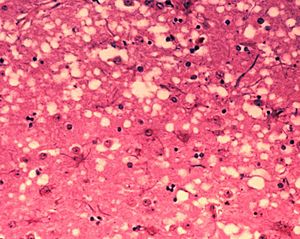Prion facts for kids
A prion is a tiny, unusual infectious particle. It's not a virus or a bacteria, but a special kind of protein. The word "prion" is short for "proteinaceous infectious particle," which means it's an infectious particle made of protein.
These strange proteins can cause serious diseases in mammals, including humans. They mostly affect the brain and other nerve tissues. Sadly, there's no cure for prion diseases right now, and they always lead to death. The word is pronounced pree-on.
Contents
How Prions Affect the Body
Prions cause different types of encephalitis, which is a brain disease. Some well-known prion diseases include scrapie in sheep, Creutzfeldt-Jakob Disease (often called Mad Cow Disease when it affects cattle), and kuru, which was found in humans.
Changing Protein Shapes
Prions work by changing the shape of normal proteins inside an infected animal or person. Imagine a protein as a long chain that folds into a specific 3D shape. Normal proteins have many twisted parts, like tiny spirals, called alpha helices.
However, when a prion comes along, it makes these normal proteins refold into a different, abnormal shape. These changed proteins have many flat parts, like sheets, called beta sheets. Once a protein changes its shape, it can then cause other normal proteins to change too, like a chain reaction.
The Mystery of Prion Reproduction
One of the biggest mysteries about prions is how they seem to "reproduce" or spread. Proteins, by themselves, cannot make copies of themselves like living things such as bacteria or viruses do.
Scientists are doing a lot of molecular biology research to understand this process. They want to find out exactly how one abnormal prion protein can cause many other normal proteins to become abnormal. This is a very active area of study, and there are no clear answers yet.
Related Pages
Images for kids
See also
 In Spanish: Prion para niños
In Spanish: Prion para niños




